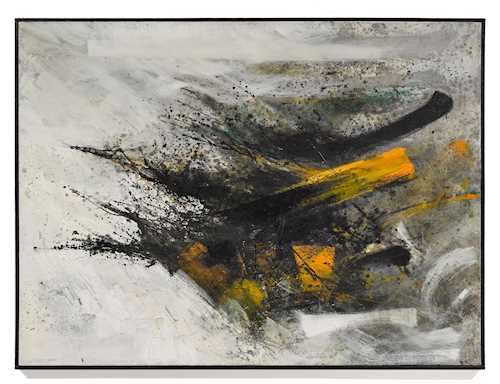
Lot 3717 - A193 PostWar & Contemporary - Saturday, 04. July 2020, 02.00 PM
HISAO DOMOTO
(1928 Kyoto 2013)
Untitled. 1961.
Oil on canvas.
Signed, dated, numbered and with location: Domoto 1961-13 PARIS, as well as signed in Japanese.
97 × 130 cm.
Provenance: Private collection Switzerland.
“Gutai art does not alter matter: it lends it life. Gutai art does not distort matter. In Gutai art the human spirit and matter shake hands with each other, although they are usually opposed to one another. Matter does not enter the spirit. The spirit does not force matter into subordination”. (Gutai Manifesto, 1956)
Hsiao Dômoto was born in Kyoto in 1928 into a wealthy family. His father was a famous collector of traditional Japanese art and his uncle Inshô Dômoto, was an equally famous Japanese painter in the Nihonga style. In his early years, Hisao Dômoto initially remained true to the family spirit and studied traditional painting at the Kyoto school of art. He enjoyed some success in Japan, but soon discovered contemporary western art, particularly at the 1952 Salon de Mai in Japan – where the emerging Japanese avant-garde, the Gutai Group, was represented – and during a trip to Europe in the same year. From then onwards he adopted western techniques, and was attracted first to Surrealism, but later devoted himself exclusively to abstract art.
Dômoto settled in France in 1955. At this time, his works were characterised by their concrete content. He initially made a name for himself with airy, romantic calligraphy in the manner of Zao Wou-Ki, and approximated the style of the Lyrical Abstraction group. While working with the Parisian Galerie Stadler between 1957 and 1960 he discovered his own style, and from 1960 developed his concept of “Solution de Continuité”. As the present painting from 1961 shows, his works from these years are characterised by an impastoed application of the paint on the canvas. His works are a reflection of spontaneous improvisation and appear to be a direct expression of his artistic feelings. He makes use of a broad and richly contrasting colour palette, so that the paint dances on the canvas like flames, wind, or frantic waves at sea with an almost meditative flow. Dômoto also seems to experiment with the ductility and malleability of colour pigments. The sometimes flowing and energetic brush strokes, the blurred areas, and the splashes of colour appeal to the imagination of the viewer: clouds, mountain landscapes, rocky formations and waterfalls take shape before our inner eye. The compositions on the canvas may burn in splendid colour, creating a powerful depth and density, with movements of both resurgence and fading away, of sunrise and sunset, bright and at the same time mysterious. The viewer is lost in a splendidly abstract landscape painting.
“Gutai art does not alter matter: it lends it life. Gutai art does not distort matter. In Gutai art the human spirit and matter shake hands with each other, although they are usually opposed to one another. Matter does not enter the spirit. The spirit does not force matter into subordination”. (Gutai Manifesto, 1956)
Hsiao Dômoto was born in Kyoto in 1928 into a wealthy family. His father was a famous collector of traditional Japanese art and his uncle Inshô Dômoto, was an equally famous Japanese painter in the Nihonga style. In his early years, Hisao Dômoto initially remained true to the family spirit and studied traditional painting at the Kyoto school of art. He enjoyed some success in Japan, but soon discovered contemporary western art, particularly at the 1952 Salon de Mai in Japan – where the emerging Japanese avant-garde, the Gutai Group, was represented – and during a trip to Europe in the same year. From then onwards he adopted western techniques, and was attracted first to Surrealism, but later devoted himself exclusively to abstract art.
Dômoto settled in France in 1955. At this time, his works were characterised by their concrete content. He initially made a name for himself with airy, romantic calligraphy in the manner of Zao Wou-Ki, and approximated the style of the Lyrical Abstraction group. While working with the Parisian Galerie Stadler between 1957 and 1960 he discovered his own style, and from 1960 developed his concept of “Solution de Continuité”. As the present painting from 1961 shows, his works from these years are characterised by an impastoed application of the paint on the canvas. His works are a reflection of spontaneous improvisation and appear to be a direct expression of his artistic feelings. He makes use of a broad and richly contrasting colour palette, so that the paint dances on the canvas like flames, wind, or frantic waves at sea with an almost meditative flow. Dômoto also seems to experiment with the ductility and malleability of colour pigments. The sometimes flowing and energetic brush strokes, the blurred areas, and the splashes of colour appeal to the imagination of the viewer: clouds, mountain landscapes, rocky formations and waterfalls take shape before our inner eye. The compositions on the canvas may burn in splendid colour, creating a powerful depth and density, with movements of both resurgence and fading away, of sunrise and sunset, bright and at the same time mysterious. The viewer is lost in a splendidly abstract landscape painting.
CHF 30 000 / 50 000 | (€ 30 930 / 51 550)
Sold for CHF 53 980 (including buyer’s premium)
All information is subject to change.

